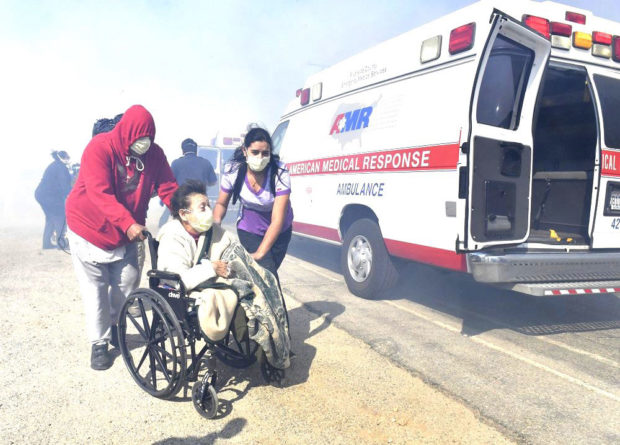Life-threatening violations by nursing homes amid California fires

A nursing home resident being evacuated during last month’s California fires. AP PHOTO
As huge swaths of California burned last fall, federal health officials descended on 20 California nursing homes to determine whether they were prepared to protect their vulnerable residents from fires, earthquakes and other disasters.
The results of their surprise inspections, which took place from September to December of 2018, were disturbing: Inspectors found hundreds of potentially life-threatening violations of safety and emergency requirements, including blocked emergency exit doors, unsafe use of power strips and extension cords, and inadequate fuel for emergency generators, according to a report released Thursday by the U.S. Department of Health and Human Services Office of Inspector General.
The nursing home residents “were at increased risk of injury or death during a fire or other emergency,” the report concluded.
The threat is not theoretical in a state that has been ravaged by natural disasters: One of the nursing homes that was inspected burned down in a wildfire afterward, so the report only includes results for the 19 remaining facilities, which it does not identify.
Bottom of Form
“The fact that one of the nursing homes inspected was later destroyed by a wildfire speaks to the grave danger residents are facing today,” said Mike Connors of the advocacy group California Advocates for Nursing Home Reform. He called the findings alarming but not surprising.
Even though the report didn’t name the nursing home that was destroyed, the California Association of Health Facilities, which represents most of the state’s skilled nursing facilities, identified it as one that burned down in the November 2018 Camp Fire, the deadliest wildfire in the state’s history.
Craig Cornett, CEO and president of the association, said all the residents were evacuated safely from that home — and from two others destroyed in the same fire. Hundreds of other nursing homes also have responded to emergencies in the past three years without loss of life, he said, which shows that “the deficiencies in the report do not reflect true facility readiness.”
The association is concerned about safely violations, he added, but “this is an example of bureaucracy equipped with blinders.”
The federal auditors said the violations occurred because of poor oversight by management and high staff turnover at the homes. But they also criticized the California Department of Public Health, the agency responsible for overseeing nursing homes in the state, for not ensuring the homes complied with federal safety and emergency requirements.
In some cases, the state’s own inspectors had previously cited nursing homes for the same problems, but did not inspect the facilities again to ensure they had been fixed, the report said.
The department “can reduce the risk of resident injury or death by improving its oversight,” the report said. For example, it could “conduct more frequent site surveys at nursing homes to follow up on deficiencies previously cited rather than relying on reviews of documentation submitted by nursing homes.”
The public health department told the auditors it had followed up with the 19 remaining homes to ensure they were addressing the problems auditors identified. But the state disagreed with the auditors’ recommendation to inspect nursing homes more frequently, saying in a letter to the auditors that federal rules don’t require onsite visits to determine whether problems have been fixed — and that the agency simply does not have enough inspectors.
The department declined a California Healthline request for comment.
The Office of Inspector General is auditing nursing homes across the nation that receive payments from the public health insurance programs Medicare or Medicaid to determine whether the facilities meet the stricter federal safety and emergency guidelines that were adopted in 2016. The auditors did not choose the 20 nursing homes randomly out of the approximately 1,200 statewide, but rather selected those in fire- and earthquake-prone regions, as well as ones already on notice for health and safety violations.
The inspectors found a total of 325 violations at the 19 homes. Among them:
- Two of the homes had pathways leading to emergency exit doors that were blocked, including one exit door blocked by a pallet.
- 16 had violations related to their fire alarm and sprinkler systems, including two that didn’t have their fire alarm systems routinely tested and maintained.
- All had violations related to electrical equipment, including using power strips that did not meet requirements or were unsafely connected to appliances or other power strips.
- Eight had not properly inspected, tested and maintained their emergency generators, which provide electricity for critical medical equipment during a power outage. Two didn’t have enough generator fuel to last 96 hours. Generator power has become critical for nursing homes in recent months amid widespread power shutdownsaimed at preventing wildfires.
- Three nursing homes’ emergency plans didn’t address evacuations.
“We don’t want reports like this,” said state Sen. John Moorlach (R-Costa Mesa). “It sounds like maybe we need to ask the state auditor to see if the site visits done by the state are being done thoroughly.”

